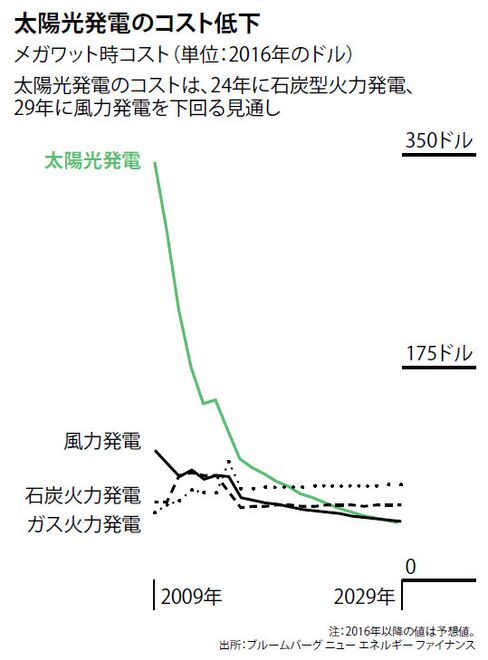ここ1、2年で、太陽光発電の世界で何かが変わった。間もなく世界中に太陽光発電が浸透すると期待しているのは環境保護主義者だけでない。冷静な公益事業担当エコノミストも今ではコスト見通しを検討し、わずか数年前ならば頭がおかしいと思われかねなかった結論に達しつつある。太陽光発電のコストは低下が続いており、今や多くの地域で石炭火力発電を下回っている。10年もしないうちに、ほぼすべての場所で風力や天然ガスを下回る、最もコストの安い選択肢になる公算が大きい。だが、コストだけが状況を変えているわけではない。屋根タイル一体型の太陽光パネルや、夜間や曇りの日に電力潮流を安定させるために必要なバッテリー技術の進歩といったイノベーションが、太陽光発電向け補助金の削減や化石燃料に肩入れする米大統領の影響を相殺している。
状況
太陽光発電設備の設置市場では中国が世界トップで、日本がそれに続く。インドは1600億ドル(約18兆1000億円)の太陽光発電プロジェクトという大きな夢を抱いている。米アップルが太陽光発電に8億5000万ドル規模の投資を計画など、一部の大企業から派手な発表も聞かれる。イーロン・マスク氏が最高経営責任者(CEO)を務めるテスラが5月に販売を開始した屋根タイル一体型の太陽光パネルも注目を集める。こうしたパネルはテスラが販売している家庭用バッテリー・パックと組み合わせることが可能だ。かつて太陽光発電に抵抗していた電力会社は、現在では自社で太陽光発電設備を建設・所有したいと考えている。建設費用を電力利用者に転嫁しつつ売り上げを伸ばせるためだ。2016年には、太陽光発電プロジェクトへの投資が17.4%減少したにもかかわらず、全米の設置済み太陽光発電能力は50%増加して41ギガワットを超えた。これはコスト低下に伴い、1ドルの投資で生み出せる電気量が増加したことを反映している。
背景
米国は太陽電池を発明したが、他国は商業化において米国よりも多くの画期的な進歩を成し遂げた。ニュージャージー州のベル研究所が1950年代前半に初めて太陽電池を製作。数十年にわたり、経済的に意味があったのは人工衛星に限られていた。73年の石油危機を受け、石油会社は太陽光を電力に変える太陽電池に投資したが、80年代に原油価格が急落すると撤退。日本では90年代を通して太陽光発電産業が生き残り、シャープ、京セラ、三洋電機が世界をけん引した。ドイツでは2004年に、再生可能エネルギーによって消費者が発電した余剰電力を電力会社が買い取ることを義務付ける固定価格買取制度(FIT)の価格引き上げが行われた。これにより、太陽光発電設備の設置が急速に進み、ドイツは数年にわたり太陽光パネル製造で世界をリードした。他国もこの制度に倣ったことから、多くの太陽光パネルメーカーが新たに誕生し、価格競争が激化。その結果、パネル価格が急落し、同産業は中国に集中した。中国では、サンテック・パワー・ホールディングスを中心に政府からの借り入れと外国人投資家による出資を受けて、企業が巨大なパネル工場を建設。そうした支援は、多くのメーカーが閉鎖に追い込まれる中で、中国企業の生き残りを支えた。設置は依然として増えており、米国では太陽光エネルギー産業の従事者数が石炭火力発電の2倍にあたる37万3000人に達した。
論点
環境保護団体のグリーンピースは長いこと、太陽光発電は世界のエネルギー需要を満たし得ると繰り返し主張してきた。ブルームバーグ ニュー エネルギー ファイナンスは、太陽光発電が世界全体の発電能力に占める割合は15年の4%から増加して40年には29%に達すると予想している。化石燃料支持派は、太陽光発電は太陽が照っていない時は発電できないため、決して実用的な電力源にならないと主張するが、太陽光・風力発電支持派は自然に左右される発電の性質に対処して行く上で必要な蓄電技術はそれほど遅れていないと反論。電力会社と規制当局は、数十年単位の予測に基づいて決定を下している。多くの電力会社は、気候変動対策に対する政治家の意欲が高まっていることから、価格面の優位性に欠けていたとしても、二酸化炭素を排出しないエネルギー源の重要性は高まるとみる。多くの場所では、太陽光発電を巡る論点は、補助金で太陽光発電を育成するべきか否かという点から、太陽光発電の利用者は送電網の維持費用をどの程度負担するべきかなど、かつては末端の問題とみなされていた論点に移っている。ケンタッキー州の石炭会社が4月、廃坑にした露天掘りの炭鉱を同州最大の太陽光発電施設に転換して元炭鉱作業員を再就職させるよう目指す意向を発表した。こうした展開は転換点という印象を告げているようだ。

Solar Energy
Something’s changed about solar power, only in the last year or two. It’s not just environmentalists who think solar will soon be everywhere. Sober utility economists are now looking at cost projections and reaching conclusions that might have been regarded as nutty just a few years ago. The price just keeps plunging. Solar power is now cheaper than coal in many places and in less than a decade is likely to fall below wind and natural gas to be the lowest-cost option almost everywhere.
But it’s not just the price that’s tipping the balance. Innovations like solar panels that double as roof tiles and progress in the battery technology needed to even out the power flow on nights and cloudy days are offsetting fading solar subsidies and a U.S. president who’s a cheerleader for fossil fuels.
The Situation
Worldwide, installations are highest in China, followed by Japan. India has ambitions for $160 billion in solar-power projects. Some big businesses have made splashy announcements, including Apple Inc.’s plan to spend $850 million on solar power. Also eye-catching were the textured-glass roof tiles Elon Musk’s Tesla Inc. began selling in May. The tiles, which resemble terracotta or slate and lie atop a standard solar cell, could combine with the home battery packs Tesla is selling as part of Musk’s push to make solar part of everyday life. And utilities — once resistant to solar power — now want to build and own farms themselves, because it allows them to boost revenue while passing construction costs to rate-payers. Overall, installed capacity in the U.S. grew 50 percent in 2016 to more than 41 gigawatts, even as investment in solar projects fell 17.4 percent — a reflection of how much more each dollar bought as prices fell.
The Background
The U.S. invented solar cells, but other countries made more of the breakthroughs in commercializing them. Bell Labs in New Jersey made the first photovoltaic cell in 1953. For decades, solar only made economic sense in satellites. Oil companies invested in the photovoltaic cells that convert sunlight into electricity following the oil crisis in 1973, then backed out when the price of crude crashed in the 1980s. Japan kept the industry alive through the 1990s, when Sharp, Kyocera and Sanyo were producing the majority of the world’s cells. In 2004, Germany introduced an expanded system of feed-in tariffs, fixed-price contracts that require utilities to pay for excess electricity generated by consumers with a renewable power source that feeds into the energy grid. The revenue the tariffs offered led to a sharp increase in solar installations, and for several years Germany led the world in solar-panel manufacturing. The tariff model was copied in other countries, and so many new solar-panel makers sprouted up that a price war followed. That led to the crash in the price of panels — and the concentration of the industry in China, where companies led by Suntech Power Holdings Co. built giant panel factories with loans from the government and cash from foreign investors — support that allowed them to survive a winnowing that shut many manufacturers elsewhere. Still, rising numbers of installers brought the total for workers in solar energy in the U.S. to 373,000, twice as many as coal.
'■<주식투자.IPO등> > 태양광·ESS·폐기물·연료전지발전' 카테고리의 다른 글
| 日本生命保険が100億円の投資.,複数の大型太陽光発電所を組み入れ、取得資産は総額3600億円見込む.運用期間20年でIRR5.5%を想定 (0) | 2017.07.06 |
|---|---|
| これからの太陽光発電、「デューデリジェンス」が事業の明暗を分ける (0) | 2017.07.06 |
| 농촌태양광발전 사업 본격화.. 농가, 농외 소득증대 기대감 (0) | 2017.07.06 |
| 한회에너지. 괌태양광발전소 60㎿급 . 65㎿h급 ESS비 1.5억$수주.현지파트너PPTC와 소유.EPC,O&M. (0) | 2017.07.05 |
| 증시도 '탈원전'…원전주 지고 신재생에너지주 뜨고 .脫원전-신재생에너지 확대 한다지만.발전비용 약 21% 증가… 전기요금 최대 10% (0) | 2017.07.04 |